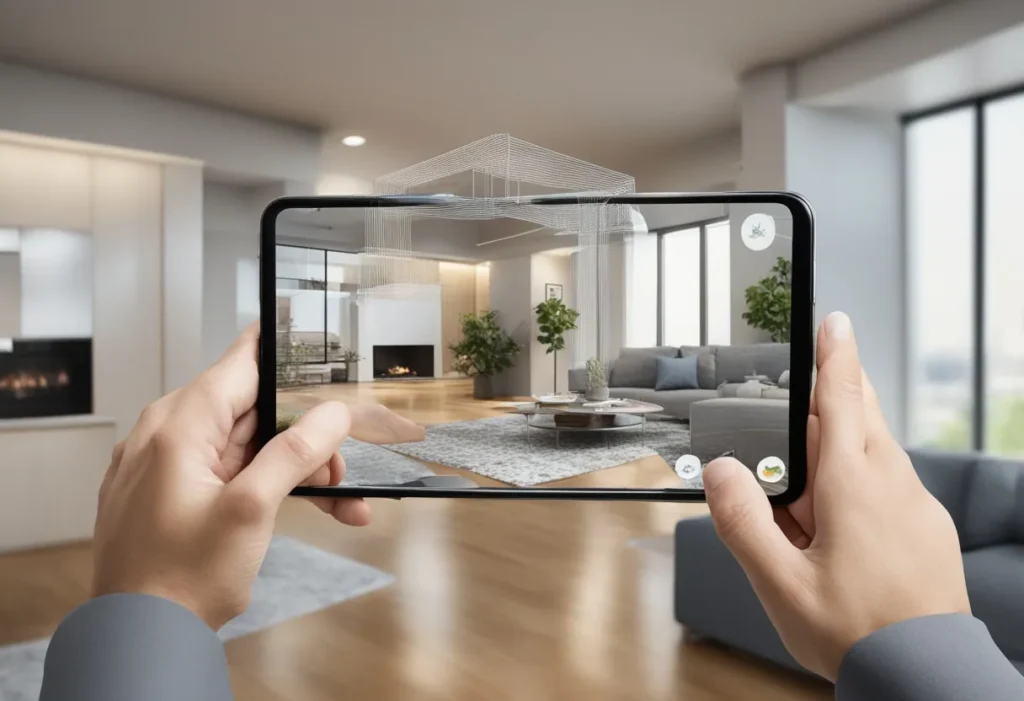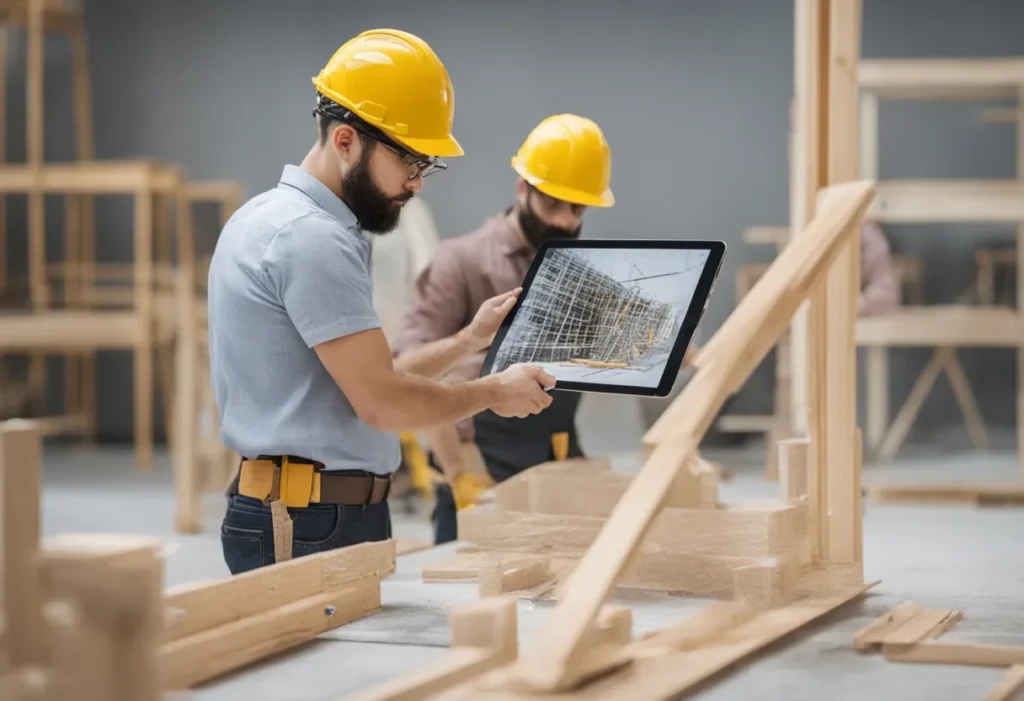The Real Estate Struggle: Seeing Is Believing
Ever tried imagining your dream home from a floor plan?
It’s like trying to picture a meal from a recipe—you kinda get it, but it’s not the same as tasting it.
That’s where Augmented Reality (AR) in real estate flips the script.
It lets buyers see, feel, and experience properties before they even step inside.
And for agents? It’s a sales weapon that turns “maybes” into “where do I sign?”

What Is AR in Real Estate, and Why Should You Care?
Augmented Reality (AR) overlays digital elements onto the real world using your phone, tablet, or AR glasses.
In real estate, this means:
- Virtual staging – Empty room? AR fills it with stylish furniture.
- 3D property tours – Walk through homes without leaving your sofa.
- Blueprint to reality – Turn flat floor plans into interactive 3D models.
- Neighbourhood previews – Check out local hotspots, schools, and amenities in real time.
- Customisation on the fly – Change wall colours, flooring, or furniture layouts in real-time.
For buyers, it means fewer disappointments and more confidence. For sellers and agents, it means faster deals and higher engagement.
How AR Is Disrupting the Real Estate Market
1. Goodbye Guesswork, Hello Informed Decisions
No more relying on vague descriptions. AR lets buyers see exactly what they’re getting—before making the trip.
2. Saves Time for Everyone
Instead of spending weekends hopping between houses, buyers can shortlist only the best ones using AR walkthroughs.
3. Boosts Buyer Confidence
Ever walked into a house that looked nothing like the listing photos?
With AR, what you see is what you get. No surprises, no wasted trips.
4. More Sales, Less Effort
Agents using AR have reported higher conversion rates because buyers are already emotionally invested before they visit.
5. Remote Buying Made Easy
International buyers, investors, or anyone relocating can view properties from anywhere in the world without a physical visit.
6. Enhances Real Estate Marketing
Listings with AR features stand out. Interactive 3D experiences get higher engagement rates, making properties sell faster.
7. Reduces Costs on Physical Staging
Traditional staging costs hundreds or even thousands of pounds. With AR, sellers can digitally furnish a home at a fraction of the cost.
Real-Life Example: IKEA’s AR Magic in Home Buying
IKEA’s AR-powered app lets users place virtual furniture in their real homes.
Now imagine this tech applied to real estate.
Buyers can see:
- How their existing furniture fits in a new space.
- How different layouts and designs work.
- How the house actually “feels” before stepping inside.
It’s not just cool—it’s a deal closer.
Another great example is Zillow’s 3D Home Tours, where buyers can navigate homes virtually as if they were there in person.
Free Tools to Experience AR in Real Estate
Want to try it yourself? Here are some free tools:
- Zillow 3D Home – Create and explore virtual home tours.
- Matterport – Turn any space into an immersive 3D experience.
- IKEA Place – Test furniture placements in real-time.
- Google Lens – Get real-time info on properties just by pointing your camera.
- Houzz AR – Redesign and visualize interiors with AR tools.
- Magicplan – Create digital floor plans with your smartphone.
- Roomstyler 3D Home Planner – Design interiors with AR visualisation.
AR vs. VR: What’s the Difference in Real Estate?
| Feature | AR (Augmented Reality) | VR (Virtual Reality) |
|---|---|---|
| Requires Headset? | No | Yes |
| Overlays Digital on Real World? | Yes | No |
| Fully Immersive? | No | Yes |
| Best For | Enhancing physical properties | Fully virtual property tours |
Both have their place, but AR is more accessible, cost-effective, and practical for real estate.

AR in Architecture: Transforming the Way We Design and Build
Augmented Reality isn’t just changing real estate—it’s revolutionising architecture too.
Here’s how AR is making waves in the design and construction world:
1. Enhanced Design Visualisation
Gone are the days of relying on 2D blueprints and static 3D models. AR allows architects and clients to walk through a building before it’s built. This helps in:
- Identifying design flaws early.
- Adjusting aesthetics and functionality in real time.
- Ensuring client expectations match reality.
2. Faster and More Accurate Construction
With AR-powered smart helmets and glasses, construction workers can see blueprints overlaid onto the actual site, reducing errors and improving precision. This leads to:
- Fewer reworks – Saves time and money.
- Better collaboration – Engineers, architects, and builders stay on the same page.
- Safer work environments – AR can highlight potential hazards before they become problems.
3. Client Collaboration Made Easy
Clients don’t need to imagine the final look from sketches. AR lets them:
- Walk through proposed structures at full scale.
- Make instant changes to design, materials, and colours.
- Interact with different architectural styles in real time.
4. Smart City Planning & Infrastructure
Governments and urban developers use AR to plan cities efficiently by:
- Simulating traffic flow before implementing road changes.
- Visualising how new buildings will fit into existing skylines.
- Testing the environmental impact of upcoming projects.
5. Cost Efficiency and Sustainability
AR helps architects and developers avoid waste by testing materials and layouts digitally before physical construction begins. This leads to:
- Lower material costs – No unnecessary waste.
- More sustainable projects – Energy-efficient designs are easier to implement.
- Reduced delays – AR-assisted workflows speed up approvals and development.
FAQs
Do I need special equipment to use AR in real estate & architecture?
No, most AR tools work on smartphones or tablets. For an even better experience, AR glasses can be used.
How much does AR cost for real estate & architectural firms?
Basic AR features are free with apps like Morpholio AR SketchWalk. Advanced setups (like custom AR models) can range from a few hundred to thousands of pounds.
Can AR speed up construction?
Yes. AR reduces errors, improves precision, and enhances collaboration, leading to faster project completion.
Can AR increase property sales?
Yes. Listings with AR features get more engagement, higher conversions, and reduced sales cycles.
Is AR better than VR for real estate & architecture?
AR is more practical and accessible for real-world applications. VR is useful for fully immersive experiences but requires more equipment.
How does AR benefit smart city planning?
AR helps urban developers simulate infrastructure projects, test environmental impact, and optimise city layouts before construction begins.
What’s stopping AR from going mainstream?
Adoption is growing, but costs and lack of awareness slow it down. However, as tech advances, it’s becoming more common.
Can AR be used for commercial real estate?
Absolutely. AR helps businesses visualize office layouts, retail store designs, and even warehouse storage optimization before committing to a space.
The Future: AR Is Here to Stay
Tech trends come and go, but AR in real estate & architecture is only growing.
Soon, we’ll see:
- AI-powered AR suggestions – Customise home designs instantly.
- Wearable AR glasses – Walk into an empty house and see it fully furnished.
- Blockchain meets AR – Secure, smart contracts with AR property verification.
- Augmented Property Inspections – Home buyers can check for hidden issues like dampness or faulty wiring with AR overlays.
- Real-Time Construction Updates – Builders and developers can showcase property progress with AR-enhanced project tracking.
If you’re in real estate & architecture and not leveraging AR, you’re leaving money on the table.
Know More: Read Related Articles on Daytalk.in
AR is not the future—it’s the present.
And those who use it? They win the real estate game.

